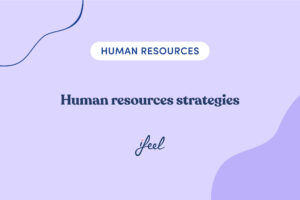Although difficult to see at first glance, the difference between feedback and feedforward is evident. It is important to be aware of the differences to use these communication tools more efficiently for our teams’ progress.
It is easier to identify them if we pay attention to them because both techniques are usually used together in the same episode of communication with the employee, either consecutively (first one and then the other) or in combination. Keep reading to find out more about the difference between feedback and feedforward.
The difference between feedback and feedforward
Both processes have in common that they are “feedback” tools when it has already happened, and it is necessary to analyse it, interpret it, and draw conclusions about it.
One of the most critical differences between feedback and feedforward probably refers precisely to this last point, the conclusions drawn. In the case of feedback, these conclusions refer technically to what has already happened, determining what part of the performance is correct and corresponds to what was expected and what part is incorrect and should be improved. Therefore, feedback looks at the past.

In the case of feedforward, the conclusions drawn are based on what has happened but look to the future: what should be done from now on, in what direction should performance be oriented in the future, what methodology or style should be adopted for projects that have not yet been completed or started.
Improving team communication
The quality of communication within teams is fundamental. At work, we communicate on many issues related to the tasks we share, and one of the objectives of this communication must be, in short, to learn to work better. To achieve this, it is beneficial to know the main difference between feedback and feedforward to apply them in the performance service.
“Communication is an ongoing day-to-day task, but it is undoubtedly a key element for all of us to work towards a common goal.”
– HR interview with Pilar Collado and Laura Risquete from González- Byass, an ifeel partner
1. Feedback messages
When we talk about feedback, formal performance reviews or more informal comments on an employee’s work results are a key context for managers to “give feedback” to their team members, as the saying goes. However, is giving feedback the only thing they do in these exchanges? Most likely not. Such communication would be of little use in promoting either improvement of poor results or the maintenance of positive results.
The most common is that the commentary on the play we alluded to at the beginning of this article contains two types of feedback, i.e., two types of messages following the execution of a task. The most famous is usually feedback, which consists of analysing in more or less detail what has been done, tracing the processes that have been carried out, and evaluating the results to assign them a favorable or unfavorable rating.
Favorable ratings are what we usually call giving employees job recognition, which is essential for strengthening relations with them and, most importantly, boosting their motivation. When it is impossible to avoid unfavorable ratings, it is crucial to give them constructively so that they fulfill their mission: to help the employee improve their performance in the future by not repeating past mistakes.
2. Feedforward messages
As mentioned above, it is unusual to comment on a task that has been performed without including messages aimed at tasks to be completed in the future, considering the learning acquired. This is where the feedforward comes in immediately after the feedback or is entwined with it.
Let’s talk about the difference between feedback and feedforward. It should be noted that the latter includes all that information about how the work should be approached in the future, what aspects of what has already been done should be avoided, enhanced, replicated, or modified, and even messages in the form of emotional incentives. Just as feedback should not be limited to pointing out what has been poorly done but rather to congratulating what has been done well, the feedforward should be motivating and inspiring for the employees who receive it.
The difference between feedback and feedforward in large organisations
The difference between feedback and feedforward is crucial for large organisations striving to enhance performance and foster growth. In large organizations, where scale and complexity can make communication challenging, balancing feedback with feedforward helps employees and leaders alike not only correct mistakes but also anticipate opportunities for development. This forward-thinking approach encourages continuous improvement and innovation, promoting a culture of progress and adaptability across the organisation.
| Tip | Description |
|---|---|
| Balance feedback and feedforward | Combine reflections on past performance with proactive guidance for future improvement. |
| Be specific and actionable | Ensure feedback is clear, detailed, and feedforward includes concrete suggestions for future actions. |
| Focus on the positive | Highlight strengths and accomplishments while offering constructive improvement suggestions. |
| Encourage open communication | Foster a culture where employees feel comfortable giving and receiving feedback and feedforward. |
| Tailor to individuals | Personalize feedback and feedforward based on each employee’s unique strengths, weaknesses, and goals. |
| Use real-time insights | Provide regular, timely feedback and feedforward instead of waiting for formal review periods. |
| Foster a growth mindset | Promote the belief that both past experiences and future opportunities are key to development. |
| Train managers | Equip leaders with skills to deliver balanced and effective feedback and feedforward to their teams. |
| Measure impact | Regularly assess the effectiveness of feedback and feedforward in achieving desired outcomes. |
| Encourage peer-to-peer feedback | Support team members in giving each other regular, constructive feedforward for continuous growth. |

Trust the leaders
At ifeel, we strongly believe in the power of constructive communication to improve performance, increase motivation and protect employee well-being.
To assist in this process, our team of psychologists specialising in mental well-being has developed a mental well-being program for companies aimed at helping companies enhance employee engagement and boost productivity.
This collaboration allows HR managers to receive personalised, data-based advice on the most effective measures for detecting employee mental health issues and assessing the workplace climate. It’s the best way to understand their needs.
Moreover, ifeel’s corporate mental well-being solution offers employees a structured mental health care service tailored to their needs at any given time.
We hope you found this post on the difference between feedback and feedforward interesting. If you would like more information about our emotional well-being program for companies, ask us, and we will contact your team as soon as possible.









